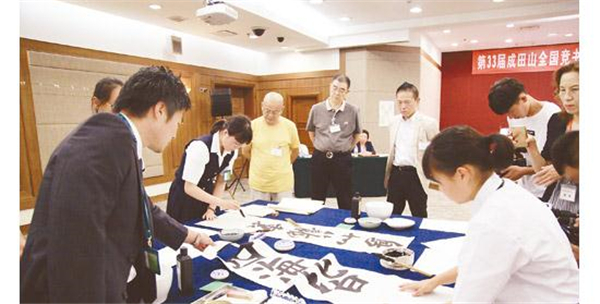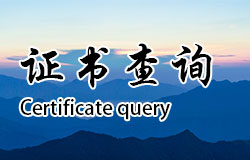On the calligraphy exchange activities between China and Japan Friendship youth at the 33rd Chengtian Mountain National Competition
Time 2019-11-12
It means that you write the contest after we come on the stage, and there is also a warm moment of mutual assistance when one side writes without hesitation and the other side helps the children to organize their paper and ink tray All of these scenes took place in the 33rd Chengtian Mountain National Calligraphy Competition conference. At the invitation of the Chinese Calligraphy Association, 46 members of the Sino Japanese Friendship young girls calligraphy exchange group, led by Akita Tanaka, vice president of the Narita national competition and director of Shinsei temple, Narita, visited China from August 4 to August 7. On August 5, a Chinese Japanese Youth Calligraphy Exchange meeting was held in Beijing. Chen Hongwu, Secretary of the Party group and vice chairman of the Chinese Book Association, he qiyetu, vice chairman of the Chinese Book Association, Cao Jianming, Deputy Secretary General of the Chinese Book Association, and Japanese Minister to China Yamamoto Gongsi sample participated in the exchange activities.
Established in 1985, Narita Mountain National Calligraphy Competition conference holds a national calligraphy competition in Japan every year to collect the calligraphy works of primary and secondary school students and children's students nationwide. Famous Japanese calligraphers select the collected calligraphy works. In the past 33 years, about 700000 young people have participated in the calligraphy competition, and more than 3 million works have been recruited, making it the most influential Youth Calligraphy Competition in Japan. Every year, the National Book contest of Mount Narita organizes the young people who have won awards to visit China for exchanges.
Among the 14 Japanese students who participated in the exchange pen meeting, Chihiro OTA, a junior high school student who won the "Lanting new star" award from the Chinese Calligraphy Association, was also a winner of the 2017 Japan national calligraphy competition. 14 students from primary, junior and senior high schools in Chaoyang, Haidian, Dongcheng and other districts of Beijing participated in the exchange, the youngest being only 11 years old, all of whom have solid learning skills.
He qiyetu, vice chairman of the Chinese Calligraphy Association, said, "calligraphy is the intangible cultural heritage of mankind. It is the common responsibility of the world calligraphy circle to protect, inherit and carry forward this intangible cultural heritage. It is an important measure to organize Youth Calligraphy Competition and carry out International Youth Calligraphy Exchange. We sincerely hope that the Chinese and Japanese youth calligraphy exchange activities will be carried out for a long time, and will continue to be carried out from generation to generation. "
On the spot, young students from China and Japan splashed ink with each other and held pen meetings. First, Japanese students write, then Chinese students write, and finally both sides write together. In such a writing arrangement, when you have finished writing, we will come on the stage, and each of the small authors will improvise a calligraphy work, which is full of competitive writing. In the process of writing, the students of both sides communicate with each other from time to time, helping each other to arrange paper, ink tray, etc., which embodies the friendship and enthusiasm of the students of both sides, and also expresses the main purpose of this exchange pen meeting.
Japanese calligraphy, like Chinese calligraphy, can not be separated from Wang Xizhi. Wang Xizhi's calligraphy was introduced into Japan during the Six Dynasties. After thousands of years of evolution, today's Japanese calligraphy and Chinese calligraphy are totally different, forming a situation of two flowers and one branch each. In the collision of the strokes you come and I go, you can see that the appearance of Japanese works is quite different from that of Chinese students' works.
As far as the use of pen is concerned, the Chinese students are more rich in brushwork. Tibetan front and oblique cut into the pen alternate with rich changes. After the writing, the tip of the pen is slowly moving and astringent, which is the form of Chinese students' writing. The Japanese students' writing is simple, neat, and flowing like a stream of clouds. In the works of Chinese and Japanese students, the more obvious difference is the treatment of the layout of the works. "Wow, it's really impressive!" Wang Xinyuan, a Chinese student, marveled at the Japanese side's Jin liangjianzhijie's live work, the soul of the pen, Haibang. Compared with the Chinese Calligraphers who will "leave the sky up and the earth down" when they write works, they will leave more places to sign. Compared with the Japanese calligraphic works, they will fill the whole space full and give people a strong visual impact.
Both Chinese and Japanese calligraphy have gone out of Wang Xizhi's way, but now they have totally different styles. This is the reason why the two countries have different footholds in the development of Calligraphy: Chinese calligraphy has always been "respecting the ancient". For thousands of years, "learning from the ancestors and standing on the tradition" has been regarded as the essence of calligraphy, belonging to the traditional school. On the other hand, in the process of developing calligraphy, learning from the ancient is not only the ancient, but also the modern spirit, which opens up the modern style of calligraphy. This pen meeting exchange made the traditional school and the modern style have a real collision. After such communication and collision, I believe that both sides will have more thinking in the future calligraphy learning.
"I was very moved by the creation of Tian Cunxi. She put the remains of her instructor beside her when she wrote her works. At such an important scene as the Sino Japanese exchange pen meeting, Tian Cunxi brought his teacher's portrait, which fully reflected his respect and love for the teacher, and also deeply reflected the quality of respecting the teacher and valuing the way that the learners should have. " Li Yi, director of the Chinese Book Association, commented on the works. He also encouraged the young people of the two countries to learn from each other and understand the essence of calligraphy through exchanges and skills, so as to become the pillar of inheriting calligraphy art in the future.


